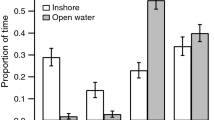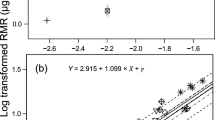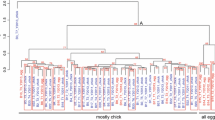Abstract
Complex marine benthic environments shape a number of ecologically important behaviors in sea urchins, including covering and righting behaviors. The present study correlated covering and righting behaviors to a series of fitness-related traits in sea urchins. Righting response time of Glyptocidaris crenularis was significantly positively correlated with body size, but significantly negatively correlated with food consumption. Covering behavior was not significantly correlated with test diameter, test height or body weight, but covering response time was negatively correlated with body weight. A significantly negative correlation was found between righting response time and covering response time. Glyptocidaris crenularis showed a significantly positive correlation in covering response time with and without exposure to poured sand, but no significance in covering ability (number of shells used to cover). The present study provides new insight into internal mechanisms and evolutionary drives of covering and righting behaviors of sea urchins.
Similar content being viewed by others
References
Adams N L. 2001. UV radiation evokes negative phototaxis and covering behavior in the sea urchin Strongylocentrotus droebachiensis. Mar. Ecol. Prog. Ser., 213: 87–95.
Agatsuma Y. 2001. Effect of the covering behavior of the juvenile sea urchin Strongylocentrotus intermedius on predation by the spider crab Pugettia quadridens. Fisherie. Sci., 67(6): 1181–1183.
Amsler C D, McClintock J B, Baker B J. 1999. An antarctic feeding triangle: defensive interactions between macroalgae, sea urchins, and sea anemones. Mar. Ecol. Prog. Ser., 183: 105–114.
Barnes D K A, Crook A C. 2001. Quantifying behavioural determinants of the coastal European sea-urchin Paracentrotus lividus. Mar. Biol., 138(6): 1205–1212.
Böttger S A, McClintock J B, Klinger T S. 2001. Effects of inorganic and organic phosphates on feeding, feeding absorption, nutrient allocation, growth and righting responses of the sea urchin Lytechinus variegatus. Mar. Biol., 138(4): 741–751.
Brothers C J, McClintock J B. 2015. The effects of climateinduced elevated seawater temperature on the covering behavior, righting response, and Aristotle’s lantern reflex of the sea urchin Lytechinus variegatus. J. Exp. Mar. Biol. Ecol., 467: 33–38.
Challener R C, McClintock J B. 2013. Exposure to extreme hypercapnia under laboratory conditions does not impact righting and covering behavior of juveniles of the common sea urchin Lytechinus variegatus. Mar. Freshw. Behav. Ph y., 46(3): 191–199.
Chang Y Q, Li Y X, Luo S B, Zhao C. 2013. Effects of different ecological environments in the laboratory on the covering behavior of the sea urchin Glyptocidaris crenularis. Acta Ecologica Sinica. 33(9): 2754–2760. (in Chinese with English abstract)
Chang Y, Ding J, Song J, Yang W. 2004. Biology and Aquaculture of Sea Cucumbers and Sea Urchins. Ocean Press, Beijing, China. p.27–217. (in Chinese)
Corning P A. 2014. Evolution ‘on purpose’: how behaviour has shaped the evolutionary process. Biol. J. Linn. Soc., 112(2): 242–260.
Crook A C. 2003. Individual variation in the covering behaviour of the shallow water sea urchin Paracentrotus lividus. Mar. Ecol., 24(4): 275–287.
Dambach M, Hentschel G. 1970. Die bedeckungsreaktion von seeigeln. Neue versuche und deutungen. Mar. Biol., 6(2): 135–141.
Dayton P K, Robilliard G A, Paine R T. 1970. Benthic faunal zo-nation as a result of anchorice at McMurdo Sound, Antarctica. In: Holgate W M ed. Antarctic ecology. Academic Press, London, p.244–258.
Dumont C P, Drolet D, Deschênes I, Himmelman J H. 2007. Multiple factors explain the covering behaviour in the green sea urchin, Strongylocentrotus droebachiensis. Anim. Behav., 73(6): 979–986.
Hagen N T. 1994). Is righting response a useful indicator of functional well-being in the green sea urchin Strongylocentrotus droebachiensis? In: David G, Feral Reds. Echinoderms Through Time. Balkema, Rotterdam. p.693–698.
Himmelman J H, Guderley H, Vignault G, Drouin G, Wells P G. 1984. Response of the sea urchin, Strongylocentrotus droebachiensis. to reduced salinities: importance of size, acclimation, and interpopulation differences. Can. J. Zool., 62(6): 1015–1021.
Hyman L H. 1955. The Invertebrates: Echinodermata. The Coelomate Bilateria, Vol IV. McGraw-Hill Book Company, New York. 763p.
Kehas A J, Theoharides K A, Gilbert J J. 2005. Effect of sunlight intensity and albinism on the covering response of the Caribbean sea urchin Tripneustes ventricosus. Mar. Biol., 146(6): 1111–1117.
Lamare M, Burritt D, Lister K. 2011. Ultraviolet radiation and echinoderms: past, present and future perspectives. Adv. Mar. Biol., 59: 145–187.
Lawrence J M. 1975. The effect of temperature-salinity combinations on the functional well-being of adult Lytechinus variegatus (Lamarck) (Echinodermata, Echinoidea). J. Exp. Mar. Biol. Ecol., 18(3): 271–275.
Lawrence J M. 1976. Covering response in sea urchins. Nature. 262(5568): 490–491.
Lawrence J M. 2013. Sea urchin life history strategies. In: Lawrence J M ed. Sea Urchins: Biology and Ecology. 3 rd edn. Academic Press, San Diego, CA. p.15–23.
Lemire M, Himmelman J H. 1996. Relation of food preference to fitness for the green sea urchin, Strongylocentrotus droebachiensis. Mar. Biol., 127(1): 73–78.
Luo S B, Chang Y Q, Zhao C, Zhou H S. 2013. Effects of the covering behavior on food consumption, growth and gonad traits of the sea urchin Glyptocidaris crenularis. Acta Ecologica Sinica. 33(2): 402–408. (in Chinese with English abstract).
Mayr E. 1960. The emergence of evolutionary novelties. In: Tax S ed. Evolution after Darwin, vol I. University of Chicago Press, Chicago, IL. p.349-380.
Millott N. 1976. The photosensitivity of echinoids. Adv. Mar. Biol., 13: 1–52.
Orton J H. 1929. On the occurrence of Echinus esculentus on the foreshore in the British Isles. J. Mar. Biol. Assoc. UK., 16(1): 289–296.
Pawson D L, Pawson D J. 2013. Bathyal sea urchins of the Bahamas, with notes on covering behavior in deep sea echinoids (Echinodermata: echinoidea). Deep Sea. Res. II., 92: 207–213.
Pearse J S. 2006. Ecological role of purple sea urchins. Science. 314(5801): 940–941.
Percy J A. 1973. Thermal adaptation in the boreo-arctic echinoid, Strongylocentrotus droebachiensis (O. F. Müller, 1776). II. Seasonal acclimatization and urchin activity. Physiol. Zool., 46(2): 129–138.
Richner H, Milinski M. 2000. On the functional significance of masking behaviour in sea urchins-an experiment with Paracentrotus lividus. Mar. Ecol. Prog. Ser., 205: 307–308.
Shang Y C. 2005. Ethology. Peking University Press, Beijing, China. p.168–188. (in Chinese)
Sigg J E, Lloyd-Knight K M, Boal J G. 2007. UV radiation influences covering behaviour in the urchin Lytechinus variegatus. J. Mar. Biol. Assoc. UK., 87(5): 1257–1261.
Verling E, Crook A, Barnes D. 2002. Covering behaviour in Paracentrotus lividus: is light important? Mar. Biol., 140(2): 391–396.
Zhao C, Zhou H, Tian X F, Feng W P, Chang Y Q. 2014. The effects of prolonged food deprivation on the covering behavior of the sea urchins Glyptocidaris crenularis and Strongylocentrotus intermedius. Mar. Freshw. Behav. Phy., 47(1): 11–18.
Author information
Authors and Affiliations
Corresponding author
Rights and permissions
About this article
Cite this article
Wei, J., Zhang, L., Zhao, C. et al. Correlation analyses of covering and righting behaviors to fitness related traits of the sea urchin Glyptocidaris crenularis in different environmental conditions. Chin. J. Ocean. Limnol. 34, 1183–1190 (2016). https://doi.org/10.1007/s00343-016-5133-y
Received:
Accepted:
Published:
Issue Date:
DOI: https://doi.org/10.1007/s00343-016-5133-y




